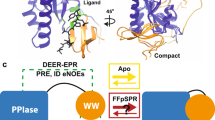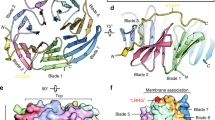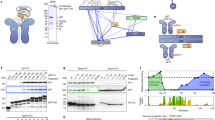Abstract
THE WW domain is a new protein module with two highly conserved tryptophans that binds proline-rich peptide motifs in vitro. It is present in a number of signalling and regulatory proteins, often in several copies1–3. Here we investigate the solution structure of the WW domain of human YAP65 (for Yes kinase-associated protein) in complex with proline-rich peptides containing the core motif PPxY (ref. 4). The structure of the domain with the bound peptide GTPPPPYTVG is a slightly curved, three-stranded, antiparallel β-sheet. Two prolines pack against the first tryptophan, forming a hydrophobic buckle on the convex side of the sheet. The concave side has three exposed hydrophobic residues (tyrosine, tryptophan and leucine) which form the binding site for the ligand. A non-conserved isoleucine in the amino-terminal flanking region covers a hydrophobic patch and stabilizes the WW domain of human YAP65 in vitro. The structure of the WW domain differs from that of the SH3 domain and reveals a new design for a protein module that uses stacked aromatic surface residues to arrange a binding site for proline-rich peptides.
This is a preview of subscription content, access via your institution
Access options
Subscribe to this journal
Receive 51 print issues and online access
$199.00 per year
only $3.90 per issue
Buy this article
- Purchase on Springer Link
- Instant access to full article PDF
Prices may be subject to local taxes which are calculated during checkout
Similar content being viewed by others
References
Bork, P. & Sudol, M. Trends biochem. Sci. 19, 531–533 (1994).
Andre, B. & Springael, J. Y. Biochem. biophys. Res. Commun. 205, 1201–1205 (1994).
Hofmann, K. & Bucher, P. FEBS Lett. 358, 153–157 (1995).
Chen, H. I. & Sudol, M. Proc. natn. Acad. Sci. U.S.A. 92, 7819–7823 (1995).
Pawson, T. Nature 373, 573–580 (1995).
Cohen, G. B., Ren, R. & Baltimore, D. Cell 80, 237–248 (1995).
Sudol, M., Chen, H. I., Bougeret, C., Einbond, A. & Bork, P. FEBS Lett. 369, 67–71 (1995).
Bork, P. & Margolis, B. Cell 80, 693–694 (1995).
Zhou, M. M. et al. Nature 378, 587–592 (1995).
Chan, D. C., Bedford, M. T. & Leder, P. EMBO J. 15, 1045–1054 (1996).
Cicchtti, P., Mayer, B. J., Thiel, G. & Baltimore, D. Science 257, 803–806 (1992).
Ren, R., Mayer, B. J., Cicchetti, P. & Baltimore, D. Science 259, 1157–1161 (1993).
Staub, O. et al. EMBO J. 15, 2371–2380 (1996).
Schild, L. et al. EMBO J. 15, 2381–2387 (1996).
Nilges, M., Clore, G. M. & Gronenborn, A. M. FEBS Lett. 229, 317–324 (1988).
Brünger, A. T. X-PLOR 3.1 Manual (Yale Univ. Press, New Haven, 1992).
Viguera, A. R., Arrondo, J. L. R., Musacchio, A., Saraste, M. & Serrano, L. Biochemistry 133, 10925–10933 (1994).
Aue, W. P., Bartholdi, E. & Ernst, R. R. J. chem. Phys. 64, 2229–2246 (1976).
Griesinger, C., Otting, G., Wütrich, K. & Ernst, R. R. J. Am. chem. Soc. 110, 7870–7871 (1988).
Jeener, J., Meier, B. H., Bachmann, P. & Ernst, R. R. J. chem. Phys. 71, 4546–4553 (1979).
Kay, L. E., Ikura, M., Tschudin, R. & Bax, A. J. magn. Reson. 89, 496–514 (1990).
Fesik, S. W. & Zuiderweg, E. R. P. J. magn. Reson. 87, 588–593 (1988).
Marion, D., Kay, L. E., Sparks, S. W., Torchia, D. A. & Bax, A. J. Am. chem. Soc. 111, 1515–1517 (1989).
Otting, G. & Wüthrich, K. J. magn. Reson. 85, 586–594 (1989).
Kraulis, P. J. appl. Crystallogr. 24, 946–950 (1991).
Nicholls, A., Sharp, K. A. & Honig, B. Proteins 11, 281–296 (1991).
Garnier, L., Wills, J. W., Verderame, M. F. & Sudol, M. Nature 381, 744–745 (1996).
Author information
Authors and Affiliations
Rights and permissions
About this article
Cite this article
Macias, M., Hyvönen, M., Baraldi, E. et al. Structure of the WW domain of a kinase-associated protein complexed with a proline-rich peptide. Nature 382, 646–649 (1996). https://doi.org/10.1038/382646a0
Received:
Accepted:
Issue Date:
DOI: https://doi.org/10.1038/382646a0
This article is cited by
-
The essential role of TAZ in normal tissue homeostasis
Archives of Pharmacal Research (2021)
-
Analysis of the role of the Hippo pathway in cancer
Journal of Translational Medicine (2019)
-
Endosomal phosphatidylserine is critical for the YAP signalling pathway in proliferating cells
Nature Communications (2017)
-
Verteporfin-induced formation of protein cross-linked oligomers and high molecular weight complexes is mediated by light and leads to cell toxicity
Scientific Reports (2017)
-
Production in Pichia pastoris of complementary protein-based polymers with heterodimer-forming WW and PPxY domains
Microbial Cell Factories (2016)
Comments
By submitting a comment you agree to abide by our Terms and Community Guidelines. If you find something abusive or that does not comply with our terms or guidelines please flag it as inappropriate.



